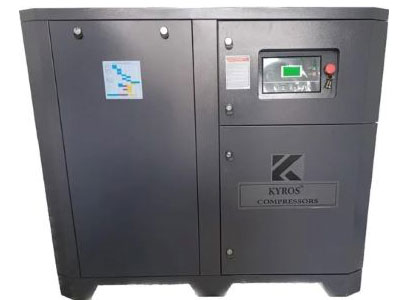Key Takeaway
VFDs are crucial in compressors, especially in rotary screw types, whether oil-lubricated or oil-free. They control motor speed, directly impacting the air output of the compressor. By adjusting motor speed based on demand, VFDs optimize energy usage, reducing wastage significantly. This capability not only saves energy but also enhances operational efficiency by matching air supply precisely to the required output. In essence, VFDs in compressors ensure cost-effective and environmentally friendly operations, making them indispensable in modern industrial settings.
Overview of Compressors and VFDs
Compressors are essential in various industrial applications, providing the necessary pressure for pneumatic tools, HVAC systems, and refrigeration units. A Variable Frequency Drive (VFD) is an electronic device that adjusts the speed of an electric motor by varying the frequency and voltage of its power supply. When applied to compressors, VFDs offer precise control over motor speed, optimizing performance based on demand. This adaptability makes VFDs a valuable addition to modern compressor systems, enhancing their efficiency and functionality

Benefits of VFDs in Compressor Applications
Variable Frequency Drives (VFDs) offer significant advantages in compressor applications, enhancing operational efficiency and reducing energy consumption. One of the primary benefits is their capability to adjust compressor output according to actual demand. Unlike traditional compressors that run at full capacity continuously, VFDs can vary motor speed to match the required air output, thereby saving energy and reducing wear on mechanical components.
Moreover, VFDs facilitate smoother start-ups and shut-downs, which minimizes mechanical stress on the compressor and extends the lifespan of critical components. This adaptability not only improves system reliability but also lowers maintenance costs over time. Industries reliant on compressed air systems, such as manufacturing and industrial facilities, benefit greatly from these features, as they ensure consistent performance while optimizing energy usage.
You May Like to Read
Energy Efficiency and Cost Savings
Energy efficiency is a critical priority in industrial settings, and Variable Frequency Drives (VFDs) are instrumental in achieving substantial savings, especially in compressor systems. By adjusting the motor speed to precisely match the required output, VFDs prevent unnecessary energy consumption. This not only lowers electricity costs but also supports environmental sustainability goals by reducing carbon emissions.
Moreover, while there is an initial investment in VFD technology, the savings in energy costs quickly offset this expense. This makes VFDs a highly cost-effective solution over time. The ability to fine-tune compressor performance ensures efficient energy use throughout operational cycles, translating into significant financial savings and environmental benefits.
For engineers entering the industry, understanding the role of VFDs in energy efficiency is crucial. It underscores their importance in optimizing industrial processes while adhering to sustainability standards and reducing operational expenses effectively. By integrating VFDs into compressor systems, industries can achieve both economic and environmental gains, positioning themselves for long-term success in a competitive global market.
Performance Improvement in Compressors
The integration of Variable Frequency Drives (VFDs) in compressors brings significant advancements in performance. By offering precise control over motor speed, VFDs enable compressors to maintain optimal operating conditions consistently. This precision is crucial for applications that require stable pressure levels, ensuring reliable output quality. Moreover, VFDs mitigate the risks associated with pressure surges and drops, thereby enhancing overall system stability and reliability.
Furthermore, the enhanced control provided by VFDs facilitates seamless integration with advanced monitoring systems. This integration enables real-time data collection on compressor performance, supporting predictive maintenance strategies. By monitoring critical parameters and detecting anomalies early, operators can proactively address issues before they escalate, optimizing compressor efficiency and minimizing downtime.
Case Studies: VFDs in Compressor Systems
Industries worldwide have embraced Variable Frequency Drives (VFDs) in compressor systems, showcasing substantial benefits through real-world examples. For instance, a manufacturing plant in India achieved a remarkable 30% reduction in energy costs by retrofitting VFDs to their compressors. This upgrade not only lowered operational expenses but also reduced maintenance frequency and costs, thanks to decreased mechanical stress on compressor components.
Similarly, a large-scale HVAC system in a commercial building demonstrated enhanced temperature control and improved occupant comfort post-VFD integration. These cases highlight how VFDs optimize compressor efficiency by adjusting motor speed to match demand, thus minimizing energy consumption during varying load conditions.
These success stories underscore the transformative impact of VFD technology, offering tangible improvements in energy efficiency, operational reliability, and cost-effectiveness across diverse industrial applications. Engineers entering the field can draw valuable insights from these examples, illustrating the practical advantages of integrating VFDs into compressor systems for enhanced performance and sustainability.
Conclusion
VFDs play a crucial role in enhancing the efficiency and performance of compressors in industrial applications. By providing precise control over motor speed, they ensure that compressors operate in accordance with actual demand, leading to significant energy savings and cost reductions. The smoother operation and reduced mechanical stress afforded by VFDs extend the lifespan of compressor components, contributing to lower maintenance costs. Real-world case studies further illustrate the practical benefits of VFDs, demonstrating their value in improving system reliability and performance. In summary, the integration of VFDs into compressor systems represents a smart investment for industries seeking to optimize their operations and reduce energy consumption.
